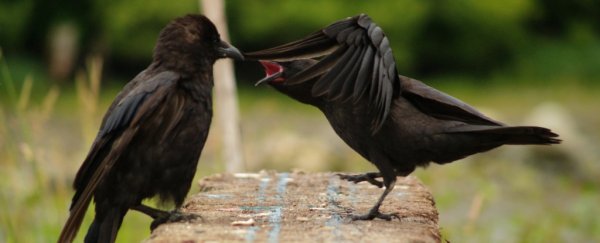You know how when one of your friends is grumpy, it brings everyone's mood down? Well, it that's not unique to humans. Turns out some of our favourite avian friends are prone to the same malady. A raven in a huff makes other ravens surly, too.
According to new research, when a raven is shown food it dislikes, other ravens nearby are less interested in their own food - even if they can't see the first raven's food. They are responding not to the stimulus, but the first raven's disgust.
Such mood-sharing is called 'emotional contagion', and it's thought that it can be a tool for sharing information, empathy and group bonding.
It's not been studied much in animals because it can be difficult to differentiate it from mimicry, or behavioural contagion. But if any animal can demonstrate social and emotional intelligence, surely it would be corvids, so well known for their problem-solving smarts.
So, an interdisciplinary team of researchers from the University of Vienna's Corvid Lab designed an experiment to determine whether ravens could 'catch' each other's moods.
Eight ravens (Corvus corax) were employed in the study, and each test was done using pairs. Each bird was tested four times, half with the positive condition and half with the negative.
First, they were given a test to establish a mood baseline. They were shown two boxes, one empty and one with a cheese treat inside. Then they were given a third box.
If they responded to this box with anticipation of a treat, the baseline was optimism. If they were indifferent - as though the box were empty - the baseline was pessimism.
For the real test, the 'demonstrator' raven was shown two boxes, one with a tasty dried dog food treat and the other with a less tasty raw carrot treat. Then one box was taken away. If the dog food treat was left, the raven was perky and happy, spending more time looking at the food and moving their head.
But if they had the raw carrot, they were noticeably unimpressed. They didn't spend as much time looking at the food, instead redirecting their attention to their environment.
Meanwhile, the 'observer' bird was in an adjoining chamber. They couldn't see the treat, but they could see the demonstrator's response to it.
Both birds were then given the baseline test again. And if the demonstrator bird had shown disappointment in the previous section, the observer bird was much less interested in approaching the third box compared to their baseline.
Interestingly, however, it didn't work the other way. If the demonstrator had been excited about the treat, that had no impact on the observer's behaviour - they approached the third box in much the same way they had before.
Only bad moods in this experiment seemed to be contagious. And the evidence suggest it was definitely the mood and not just behavioural mimicry. The observer birds picked up on the demonstrators' frustrated behaviours, and were more pessimistic afterwards, but they did not exhibit the same behaviours.
This suggests that emotional contagion can occur independently of behavioural contagion - and that emotional contagion could play an important role in group dynamics in these birds.
"Research has advanced and we no longer follow the idea that emotions are less important than for example cognitive skills," said experimental psychologist Jessie Adriaense of the University of Vienna.
"Just like humans, animals are driven and motivated by their emotional states, which is reflected in their cognitive performance and behavioural expressions. Although it remains a challenging research endeavour, this study demonstrates we're heading in the right direction."
The research has been published in PNAS.
